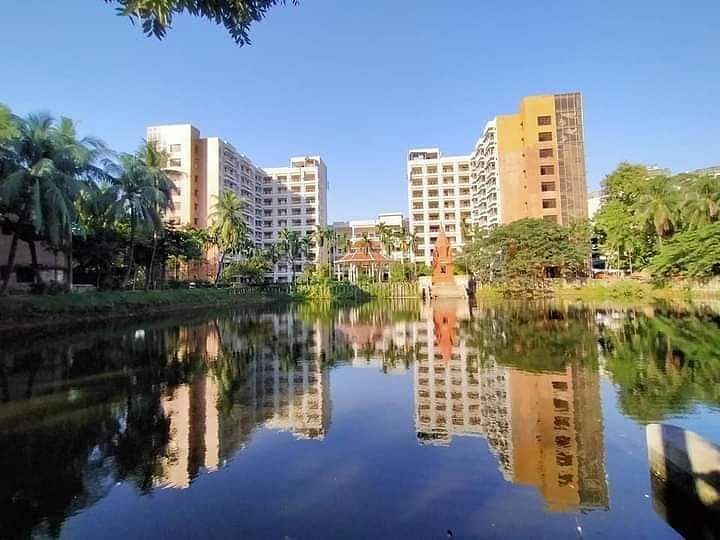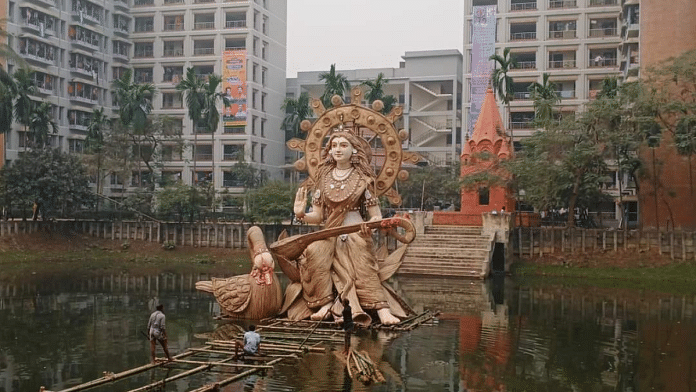Nilay Kumar Biswas is safe in room number 7017 of Santosh Chandra Bhattacharya Bhaban in Dhaka University’s Jagannath Hall. This nondescript room, with four beds and desks, is Biswas’ sanctuary, as are the other residences, libraries, meeting rooms, dining halls, gardens, and grounds that comprise Jagannath Hall—the university’s historic hostel complex for non-Muslim students. Now, Durga Puja celebrations have begun and there are already reports of alleged attacks on Bangladeshi Hindus and pandals.
“Inside Jagannath hostel, I feel safe as a Hindu. I can enjoy Durga Puja. But what about the world outside?” asks Biswas, who is pursuing a one-year Master of Social Science programme in the university’s Department of Mass Communication and Journalism.
Against the backdrop of rising Islamic fundamentalism in Bangladesh, it hasn’t been easy for the country’s eight per cent Hindu minority in recent years. But Jagannath Hall is one of the few places in Bangladesh where pluralism is not just tolerated but celebrated. Here, Hindu, Christian, and Buddhist students can enact their religious differences without fear of reprisal.
It’s a hard-won freedom in the hall’s 102-year-old history.
On 25 March 1971, the Pakistan Army’s massacre of teachers and students in Dhaka University, named Operation Searchlight, would snowball into the Bangladesh Liberation War, joined by the minority students in large numbers.

“If a protest against an objectionable comment on Durga Puja by a ruling party MP is met with violence on Hindus by his supporters, what hope do we have of celebrating Durga Puja without fear?” says Biswas, recalling an incident earlier this month where members of the Bangladesh Hindu Buddhist Christian Unity Council, the largest minority association in the country established in 1988, were attacked by the supporters of Awami League MP AKM Bahauddin Bahar. The council members were protesting against Bahar’s insinuation that pandals and drug abuse went hand in hand. “Let’s start pujas free from drugs. Please write over the pandals that this puja is free from drugs,” Bahar had reportedly said.
Students of Jagannath Hall, University of Dhaka are protesting against the communal attack in Bangladesh#StopCommunalAttack#SaveBangladeshiHindus#BangladeshiHinduWantSafety#SaveHindus#SaveHinduTemples#SaveHumanity#BangladeshAgniveer pic.twitter.com/4LYBRWiKwB
— Bangladesh Agniveer (@BDAgniveer) October 17, 2021
Biswas and other Hindu students at Dhaka University fear that violence may escalate as Bangladesh gets ready to hold the national election in January 2024.
Every festive season, instances of vandalism and hate crimes from Bangladesh seep into mainstream news in India as well. After four people were killed when a mob vandalised Hindu temples during Durga Puja in 2021, the Sheikh Hasina government deployed paramilitary forces to protect pandals across the country. A similar exercise was repeated in 2022 as well. This year, though, a lesser number of attacks have been reported and over 200 pandals have been added to Durga Puja celebrations, according to a minority community leader.
Also read: Bangladeshi Muslim YouTuber solved oldest Durga Puja riddle. He’s a star with 1.63m subscribers
A place for celebration, ideas
Shoumik Ahmed Anik, a non-resident student who had come to visit Biswas, is visibly upset by this communal tension. He celebrates Durga Puja with his Hindu friends every year. “There are other Muslim students like me who do the same. If you go to the villages, you will see many Muslim villagers at Durga Puja pandals, soaking in the festivity,” he says.
One of the most important festivals of Hindus in #Bangladesh, #SaraswatiPuja celebrated across the country; The festival was celebrated on a grand scale at the Jagannath Hall of Dhaka University. Watch this Report: pic.twitter.com/mCVJZFxWA6
— DD News (@DDNewslive) January 30, 2020
Ahmed Anik, a student of political science, questions the need for Dhaka University to have a separate space for non-Muslim students. Times have changed, he argues. “In a secular Bangladesh, there should be no need for a space like Jagannath Hall to house minority students.”
There’s a festive sparkle across the five bhawans on the campus. Unlike the pandals outside, which are decorated to the hilt, the upasanalay, where the 10-foot idol of Durga is housed, is not themed. Mihir Lal Saha, the provost of Jagannath Hall and puja committee president, is quick to clarify that the upasanalay is not a pandal.
“It’s a common praying space at Jagannath Hall for Hindus, Buddhists, and Christians, and this is where Durga Puja is held every year,” he says.
For five days, thousands of people will come to celebrate and attend the pujas, irrespective of class, caste, and religion, says Saha. “Many Muslims come. The ministers come as well, though not to attend the pujas,” Saha adds.
The Akal Bodhon (untimely incarnation of the goddess) on the sixth day kicks off the puja celebrations, which fell on 20 October this year. The Saptami puja happens on the following day with an aarti in the evening. Khichdi prasad is served every day for an hour after puja. On the last day, Dasami (24 October), the idol will be immersed in a pond within the campus.
But tensions that erupted after the MP’s comments have filtered into the safe walls of Jagannath Hall.
“This is not an isolated incident,” says another resident of Santosh Chandra Bhattacharya Bhaban, who is completing his masters in international relations and does not want to be named. “Hindus in Bangladesh live in fear during Durga Puja every year.”
According to him, not all vandalism incidents are reported in the mainstream Bangladeshi press. “But here, in the relative safety of Jagannath Hall, we discuss these incidents and have heated debates on the future of Hindus in this country, and yes, celebrate Durga Puja in peace,” he says.
While Jagannath Hall has been a safe haven for free flow of ideas, he says, “It also paid a heavy price for it.”
Also read: Tarique Rahman — Hasina’s top rival, Bangladesh’s ‘fugitive dark prince’ eyes BNP revival in…
Jagannath Hall’s bloody history
Jagannath Hall, which was inspired by Oxford University and established in 1921, is inexorably linked with the Bangladeshi Hindu community. Today, a white memorial stands as a silent sentinel to the massacre that took place on 25 March 1971, when the army stormed the quarters of Jagannath Hall.
Professor of philosophy Gobinda Chandra Deb and then-provost Jyotirmoy Guhathakurta, after whom two hostel buildings of Jagannath Hall were named, were killed along with over a hundred students, administrative staff, and teachers.
The following day, Bangladesh declared its independence from Pakistan, fighting a war that lasted over eight months. Ranjan Karmaker, one of Bangladesh’s prominent minority leaders, was a resident and general secretary of Jagannath Hall’s student council between 1978 and 1984. That period was marked by a wave of repression upon the hall residents.
“After the massacre on 15 August 1975 that saw the killing of Bangabandhu Sheikh Mujibur Rahman and many of his family members, the rise of General Ziaur Rahman led to a climate of fear among Hindus. Zia felt we were aligned with Mujib’s ideas of secularism as a bedrock for our newly liberated country,” says Karmaker, a presidium member of the Bangladesh Hindu Buddhist Christian Unity Council.
“Jagannath Hall is a safe space today. It wasn’t before.”
The student wing of the Bangladesh Nationalist Party as well as the administration came after students like Karmaker, who protested Zia’s move to “tear apart the secular fabric of Bangladesh”. As a young man in Jagannath Hall at the time, the minority leader recalls sleepless nights. He had been elected student leader of the dormitory.
“But I could not sleep in my own hostel room in Jagannath Hall, as there was surveillance by Zia’s loyalists inside the Dhaka University campus. They would sneak inside our rooms at night. There were constant threats of attacks on Hindu and other minority students,” he says.
Jagannath Hall is made up of five bhawans or hostel buildings: Santosh Chandra Bhattacharya Hall, Rabindra Hall, October Memorial Hall, Gobinda Chandra Deb Hall, and Jyotirmoy Guhathakurta Hall. The 2,000-odd students who call it home are proud to be part of Dhaka University, which was established in 1921. Today, the university has more than 83 departments and 56 research centres, with an alumni list that reads like the who’s who of Bangladesh—from Nobel Laureate Muhammad Yunus to author Taslima Nasrin.
All’s not well but dissent is allowed
Today’s generation of minority students are not shackled to the diktats of any regime. And so they hold forth on festivals, vandalism, and uncomfortable perceptions of Rabindranath Tagore. Outside Jagannath Hall, students from other hostels of Dhaka University don’t see the Bengali poet as the sage-like national icon that he is to India. Rather, many Bangladeshis describe him as a Hindu zamindar who hardly wrote about Bengali Muslims.
“To say we are seen as ‘the other’ by Muslim students in Dhaka University is not true. But it is also true there are undercurrents that happen only because you are a minority student staying in Jagannath Hostel,” says a resident who does not wish to be named.
Casual, hurtful taunts of being an “Indian agent” are common.
Karmaker is happy that students are discussing Bahar’s comments and the subsequent attack on the protesters. However, he insists that the incident does not represent the sentiment across Bangladesh.
Across the country’s 299 constituencies, there is a wave of Durga Puja festivities and fervour. The number of pandals has been going up every year. “Last year, there were 32,168 Durga Puja mandaps. This year, the number has increased to 32,408,” Karmaker says.
He adds that the secular Awami League is welcoming toward minorities.
“Every time the Awami League went out of power—from 1975 to 1996, or in 2001—Hindus in Bangladesh suffered,” he says.
Political changes and unrest almost always reverberate in Jagannath Hall. When the Bangladesh Nationalist Party-Jamaat-e-Islami Bangladesh coalition came to power in 2001, lawmaker Nasiruddin Ahmed Pintu launched midnight raids in campuses to search students who could be Awami League supporters. According to Karmaker, residents were humiliated and assaulted during the rampage.
Student residents like Biswas and Saha may not agree that things are better with the Hasina government, but dissent is accepted here.
“Jagannath Hall remains a microcosm of minority sentiment for the whole of Bangladesh,” says Karmaker.
(Edited by Humra Laeeq)



